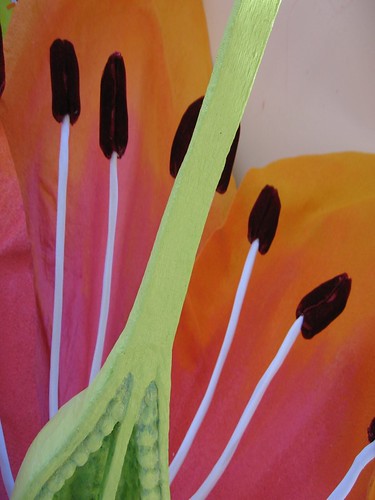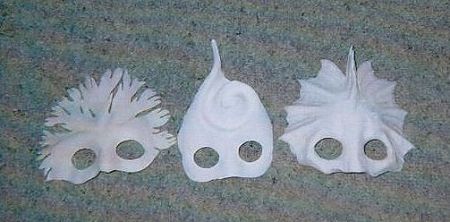Reading about stretchy circuit board development, it says that stretchiness is needed as well as thinness. I wonder if anyone has thought along the lines of a fibre mesh? (I’d guess so!) For instance, with paper mache, if you want to wrap around very smoothly, you use very small pieces of paper, and you expect the fibres on the torn edge to mesh with the layer underneath to make the curved surface smooth. Likewise with wool felting, the scales and crimps in the wool fibres engage through friction to make a mesh, which gives felt the ability to be stretched and molded. Maybe circuit board components could be made in a fibre form which would mesh in a similar way?
felt
A strange girl
My friend Lynda would like to know seven strange things about me… Thanks, Lynda.
- I disliked dolls as a child, but loved teddy bears and other animal toys. My favourite was a panda I was given when I was about 4. I was fluent in Panda talk. Another favourite was a little German-made bear that I was given to keep in my pocket on the plane when my family moved from South Africa to Australia when I was seven. (I don’t think he is a Stieff bear, because I don’t remember him ever having a stud in his ear, but he is a dead-ringer for Peter Bull’s bear, Theodore, that sold for a fortune in 1995.)
- When I was little I used to save up my pocket money for 10 weeks to buy little felt mice from a tiny shop called The Acorn in the Adelaide Hills. They had tartan clothing, and you could get girl and boy mice. Later I started to make them for myself, and I had a whole family of them, all with alliterative names like Miranda Mouse. I also made them things like tiny books, bags and babies. I still have some, and I still make them occasionally. There are notes on the photo if you follow its link through to Flickr.
- When I was about 12 I went through a phase of carving rabbits in the ends of matchsticks.
- Another early foray in craft was making miniature gonks in football colours for friends at school. Gonks were a 60’s fad, essentially humpty dumpties with big hands and feet, and a fuzzy tuft of hair.

- At about the same age I started making soft toys from patterns in women’s magazines, only I often made them straight from the miniature pattern on the page, rather than scaling them up
- We have a couple of treasured crocheted blankets made by grannies in the family, but on the whole I dislike crocheted objects. Amigurumi drive me nuts. I don’t know why.
- I find it very difficult to tag people; not sure why. (I also have a telephone thing, have to push myself to telephone at times). So if any of my blogging friends would like to take up the meme and run with it, please do, and let me know in comments here.

Giant cross-section flower
My third project for Floriade was making a giant model flower in cross-section, to be the central display in CSIRO’s Division of Plant Industry’s information tent. I really enjoyed making this, too. Some projects go really easily and this was one of those!
The petals were the main challenge, but I decided pretty quickly to use a molded felt technique that I had previously tried with some masks. Essentially you saturate felt in white PVA glue, mold it to the shape you want, and then let it dry. It adopts the shape and becomes fairly hard and plasticised in a way. You can paint it, too, and the way the paint bleeds through the felt can be used in different ways, some quite sensuous. In this case, I made a petal shape in clay and each petal had a double layer with some aluminium flat bar running up the middle to give it extra rigidity. The interesting thing about the technique apart from the obvious texture, is that the felt can be stretched and pulled but remain in one piece. In this respect natural wool felt is much better to work with because it pulls and moves much more than synthetic felt. But synthetic is okay if you don’t have a choice.
I think the flower may end up being displayed in the CSIRO Discovery Centre, where some of my insect models are too; I hope so.
Dave Riley’s Mask Studio tutorials
Dave Riley is a mask-maker, puppeteer and playwright based in Brisbane. His Mask Studio tutorials have been of great help to me a number of times – thanks Dave! There are two mask tutorials:
- Easy mask making using cheap plastic originals (creating a serviceable neutral mask from a cheap plastic model, and then making it into a character mask by adding styrofoam and compressing it to shape).
- Mask making methods using commercial felt.
The felt method is really interesting. It involves soaking the felt in white glue and then moulding it to shape rather like working leather. There are then different finishes to experiment with, including paint, and leather gloss and polish. The result is a very light strong mask.
A few years ago when I first tried it and made a series of animal masks, I built on a paper mache base because I wasn’t sure it would be strong enough otherwise, but recently in making some smaller masks for Hidden Corners’ ‘See Beneath’, I was more confident in using the felt by itself, with a muslin/white glue backing to make the inside comfortable and strong.
The seaweed fronds had a little extra strengthening, just because the shape was not intrinsically strong like the shell. The fishy mask was done a little differently, without felt because I wanted finer detail. It is carved quite thinly out of styrofoam, and has several layers of muslin and white glue to give it strength.
These have a water-based polymer gloss varnish added to the paint, which kind of plasticizes them.






